
| Court art of Sogdian Samarqand in the 7th century AD | |||||||||||||
| Home | General | Western Wall | Northern Wall | Eastern Wall | Southern Wall | Bibliography | |||||||
 |
|
|||||||||||||||||||||||||||||||||||||||||||
Southern wall

In our opinion it is very easy to recognize that the mural composition is focused on the oversized rider. Therefore, all the other acting people before and behind this person are subordinate.
This observation is essential to interpret the procession as a whole and several details of it:
1. The leading elephant plays the most inferior part in the procession. From this follows that all reconstructions of a princely figure as rider of this animal can be rejected. Most probably we have here a riding music band. Look at our solution concerning this mural part.
2. Behind the elephant follows a group of court ladies.
3. Then comes a more important part: two camel riders furnished with ceremonial staffs introduce what is in the centre of the wall.
4. The importance of the actors rise to the sacred central group: A leading person by foot, than a horse without rider, above the animal a row of four birds, and at the end a second person. The two persons mentioned have priestly functions as is indicated by their padam (a piece of fabric bound before the mouth).
5. Following is the compositional focus with the oversized rider, most probably being king Varxuman.
6. In the end comes the suite of the oversized rider.
Our conclusion is as follows: With the rejection of a princess on the elephant (cp. above) all interpretations of the composition as a wedding cavalcade vanish into thin air. The sacred horse in the centre of the murals may give a hint to the purpose of the procession: The splendid bridled animal suggests a connection with a funerary ritual. An interpretation of this kind is supported by several parallels from pictorial sources as well as from Tadzhik and Uzbek ethnographic materials. At this point we must refer to our printed discussion [Mode 1993].
If we take the cavalcade as a funeral procession, then we have to ask for the subject of this ritual. Any proposal concerning this must remain hypothetical. But if we remember king Varxuman as patron of the murals, and if he was really the oversized rider depicted on the southern wall, then it seems not impossible to interpret the scene as funeral procession of some relative to king Varxuman himself.
Back to previous page of this overview.
 |
|
|||||||||||||||||||||||||||||||||||||||||||